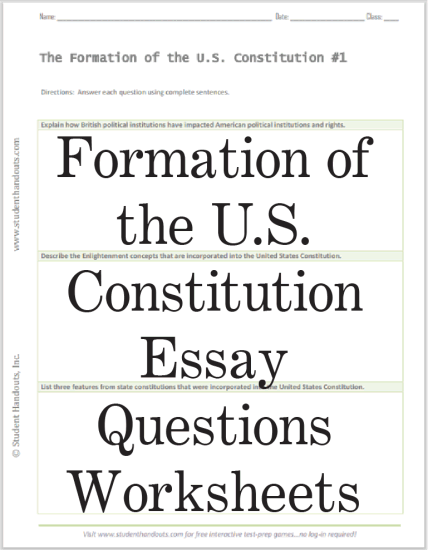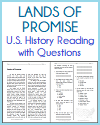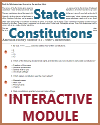| Formation of the U.S. Constitution Essay Questions Worksheets |
|---|
| www.studenthandouts.com ↣ U.S. History ↣ Forming a National Government ↣ Worksheets |
 |
   |
|
Constitution Essay Questions Worksheet #1 1. Explain how British political institutions have impacted American political institutions and rights. British political institutions profoundly shaped their American counterparts. The colonial experience with Parliament inspired the U.S. Congress as a bicameral legislature, while the concept of a unwritten constitution evolved into a single, supreme written document. Most significantly, the English tradition of common law and documents like the Magna Carta established the foundational principle of individual rights and liberties, which were codified and expanded in the U.S. Bill of Rights. This legacy created a system that adapted British principles to reject monarchy and aristocracy. 2. Describe the Enlightenment concepts that are incorporated into the United States Constitution. The U.S. Constitution embodies key Enlightenment concepts. From John Locke, it incorporates the ideas of natural rights and popular sovereignty, establishing a government legitimized by the consent of the governed. The framework reflects Montesquieu's principle of the separation of powers, dividing authority among three branches to prevent tyranny. Additionally, the document itself exemplifies social contract theory, creating a government designed to protect individual liberties through a rational, structured system of laws. 3. List three features from state constitutions that were incorporated into the United States Constitution. Three key features from state constitutions were incorporated into the U.S. Constitution. First, the bicameral legislature, modeled on Pennsylvania's and other colonial structures, created a two-house Congress. Second, the inclusion of a strong executive branch with veto power, drawing from the powerful governors in states like New York. Finally, the Bill of Rights was directly inspired by existing declarations of rights in state constitutions, such as Virginia's, which guaranteed individual liberties against government power. Click here to print. Answers will vary. |
|
Constitution Essay Questions Worksheet #2 1. List two strengths and two weaknesses of the national government under the Articles of Confederation. Two major strengths of the national government under the Articles of Confederation were its ability to successfully wage the Revolutionary War and its passage of the Northwest Ordinance of 1787, which established a process for admitting new states and banned slavery in the Northwest Territory. Its critical weaknesses were the inability to tax, leaving the government bankrupt, and the lack of power to regulate interstate commerce, which led to economic disputes between states. These flaws demonstrated the need for a stronger federal structure. 2. Define the term "critical period." The "Critical Period" refers to the era from 1781 to 1789, under the Articles of Confederation. This term describes the severe weaknesses of the national government, which lacked the power to tax, regulate commerce, or enforce treaties. These failures led to economic chaos, interstate conflicts, and domestic unrest like Shays' Rebellion. The period was "critical" because the survival of the young nation was in doubt, directly motivating the 1787 Constitutional Convention to create a stronger federal government. 3. Describe the men who served as delegates at the Constitutional Convention. The delegates to the Constitutional Convention in 1787 were predominantly wealthy, educated, and experienced men. Many were lawyers, merchants, and plantation owners, and a significant number had served in the Continental Congress or fought in the Revolution. Figures like George Washington, James Madison, and Benjamin Franklin provided leadership. Notably absent were small farmers, artisans, and enslaved persons, making the assembly an elite body that, while deeply knowledgeable, did not reflect the full diversity of American society. Click here to print. Answers will vary. |
|
Constitution Essay Questions Worksheet #3 1. Select two weaknesses of the Articles of Confederation and explain how these weaknesses were remedied by the United States Constitution. Two critical weaknesses of the Articles of Confederation were the national government's inability to tax and its failure to regulate interstate commerce. The Constitution remedied these by granting Congress the power to "lay and collect Taxes" (Article I, Section 8) and to "regulate Commerce with foreign Nations, and among the several States" (the Commerce Clause). These new powers provided the federal government with essential revenue and the authority to resolve economic disputes between states, ensuring greater stability. 2. African Americans and women were excluded from the Constitutional Convention. How was this fact reflected in the resulting United States Constitution? The exclusion of African Americans and women was directly reflected in the Constitution's original text. It enshrined slavery through compromises like the Three-Fifths Clause and the Fugitive Slave Clause, denying enslaved individuals personhood and rights. Furthermore, the Constitution used gender-neutral terms like "person" or "citizen," which, by the era's legal and social standards, applied exclusively to men in matters of voting and office-holding. This effectively codified the political disenfranchisement of both groups, protecting the interests of the propertied white male elite. 3. Describe the compromise(s) reached over the issue of slavery. The Constitution reached several critical compromises over slavery. The Three-Fifths Compromise counted enslaved individuals as three-fifths of a person for congressional representation and taxation, boosting the South's political power. Furthermore, the Commerce Compromise prohibited Congress from banning the international slave trade for twenty years. The Fugitive Slave Clause also mandated that escaped enslaved persons be returned to their owners, even if they reached free states. These agreements protected the institution of slavery to secure Southern support for ratification. Click here to print. Answers will vary. |
| www.studenthandouts.com ↣ U.S. History ↣ Forming a National Government ↣ Worksheets |








